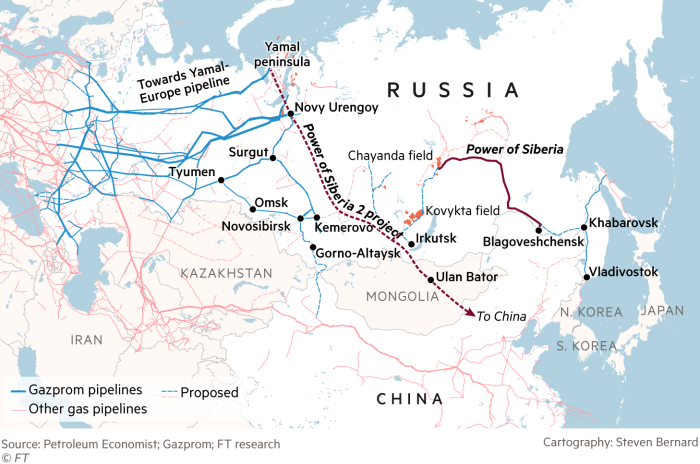Power of Siberia 2: Significant Shift in Global Gas Markets or Another Pipe(line) Dream?
Source: https://www.ft.com/content/541f8bcb-118a-419e-869f-3273fcc9ce92
Power of Siberia 2: Significant Shift in Global Gas Markets or Another Pipe(line) Dream?
On September 2, 2025, Russian gas giant Gazprom and China National Petroleum Corporation (CNPC) signed what has been described as a “binding” memorandum of intent” (MOI) to build the Power of Siberia 2 gas pipeline that would convey gas from Russia to northeastern China via Mongolia. The MOI obligates the parties to continue negotiations, but the international media has largely interpreted the MOI as a fait accompli that could “reshape global energy markets.” Many thorny issues remain to be settled, however. According to Gazprom Chairman Alexei Miller, the two sides have yet to work out the price of the gas and the financing for the project—key details that are essential to its fruition.
What we know so far, however, is that Russia intends to build the pipeline. In fact, Russia needs to build this pipeline, as the market for Russian gas has collapsed in Europe and the European Commission plans to phase out gas imports from Russia entirely by 2027. Russian gas exports to Europe have nosedived to the lowest levels since the 1970s and current gas deliveries to China only make up for 20% of the volume previously piped to Europe.
Russian President Vladimir Putin was enthusiastic about the pipeline in his comments to journalists, hailing the “mutually beneficial agreements” signed after protracted negotiations. “Everyone is satisfied, everyone is happy with this result, to be honest, and I am too,” Putin said.
Mongolian Prime Minister Gombojav Zandanshatar was equally effusive, calling Power of Siberia 2 an “unprecedentedly large-scale project, not in a century but in a millennium.” Although the Prime Minister foresees great opportunities for Mongolia in the future with the construction of the pipeline, the Mongolian government is not counting on them any time soon, omitting gas from this Russian pipeline from its energy supply projections to 2028.
It remains unclear what China plans to do or what Beijing is signaling. By agreeing to a provisional memorandum, President Xi Jinping shows support for Putin, but without committing China to any specific gas purchase or investment of funds. China is still considering boosting gas volumes from Turkmenistan via the construction of a fourth pipeline (known as Line D), so it remains unclear if/when CNPC would need the additional 50 bcm this second Siberian pipeline would provide. Moreover, this pipeline would ship gas to northern China, which needs it less than southeastern provinces. Some experts argue that the prospect of a new Russia-China gas pipeline may give Beijing more leverage in future contracts for purchases of LNG and reduce PRC demand for US LNG.
If this is the deal of the century, the PRC media certainly has been quiet about it. Xi Jinping—no shrinking violet about his country’s achievements—has said not a word about a new pipeline from Russia. The Chinese Foreign Ministry notably dodged a question from Bloomberg about it. CNPC did not mention the agreement on its website. The PRC official readout from the Xi-Putin summit mentions that various agreements were signed, including on energy, but provides no specific mention of this pipeline. The documents from the Xi-Putin summit meeting have yet to be published, so it is unclear what they agreed to do specifically. Victor Gao, Chairman of the China Energy Security Institute in Beijing, called the Russian announcement “premature” given the lack of an actual agreement.
A Chinese observer noted that the price of Gazprom’s shares fell 3% immediately on the Moscow Exchange—a $3 billion loss— after the announcement of the MOI with CNPC. This is odd considering that Power of Siberia 2 is supposedly the answer to Gazprom’s prayers for a new gas market. According to this PRC observer, the fall in the share price could be explained by: 1) concern about the ultimate completion of the deal—after 20 years of talks there still is no supply contract; 2) the low price CNPC may be demanding, foreshadowing future Gazprom losses; and/or 3) the amount that Gazprom would need to invest itself to build the 2,600km (1615.5 miles) pipeline—$25 billion at current exchange rates.
Where’s the risk? Gazprom’s falling stock price clearly shows the risks to Russia—a lack of leverage with China over pricing, the absence of financing to build the pipeline, and a growing dependence on the Chinese market. For China, there’s also a risk of depending too much on Russian supplies—currently 33% of China’s pipeline gas comes from Russia. The Sino-Russian partnership notwithstanding, China has sought to diversify its supplies. The recent attack on Iran may have made overland energy supplies more attractive than Persian Gulf imports, but overland pipelines also are vulnerable to interruption. And then there’s Mongolia, which declined to upgrade its role in the Shanghai Cooperation Organization and pursues a line of engagement with democracies—“the third neighbor policy.” For China, this magnifies the risk of adding a transit country to the mix. Although Mongolia would benefit from transit fees and access to gas—especially important given its severe air pollution problem—the pipeline would add to the pressure the country already feels from its economic dependence on its two big neighbors.
Even if the Power of Siberia 2 project is no pipe(line) dream, it may not be the game-changing deal portrayed in the media. Stay tuned for updates as the documents from the China-Russia summit become available. For background on the Power of Siberia pipeline and its potential successor, see https://www.chinasresourcerisks.com/post/pipeline-khanfluence-power-of-siberia-2-to-go-through-mongolia-to-china


